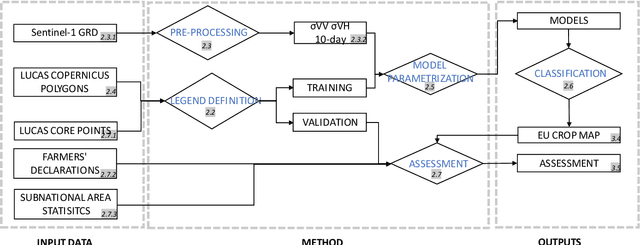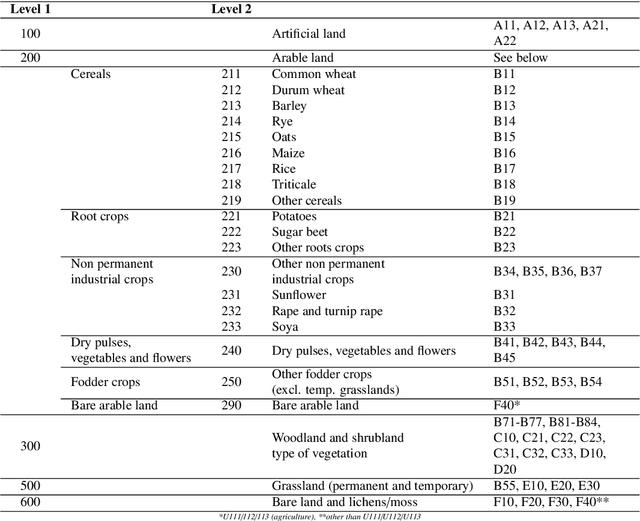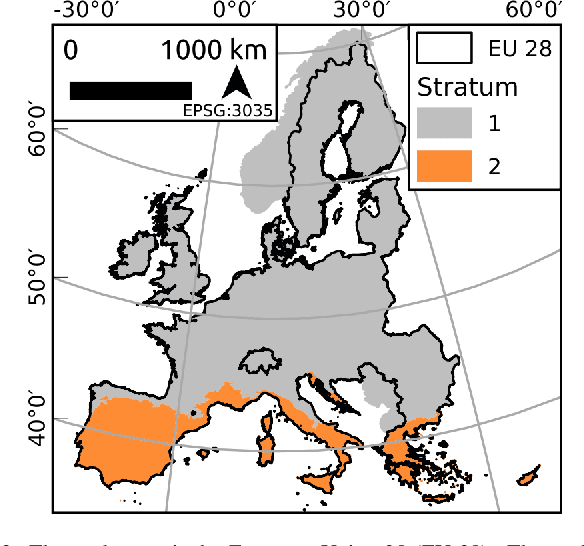Michele Meroni
From Rows to Yields: How Foundation Models for Tabular Data Simplify Crop Yield Prediction
Jun 23, 2025Abstract:We present an application of a foundation model for small- to medium-sized tabular data (TabPFN), to sub-national yield forecasting task in South Africa. TabPFN has recently demonstrated superior performance compared to traditional machine learning (ML) models in various regression and classification tasks. We used the dekadal (10-days) time series of Earth Observation (EO; FAPAR and soil moisture) and gridded weather data (air temperature, precipitation and radiation) to forecast the yield of summer crops at the sub-national level. The crop yield data was available for 23 years and for up to 8 provinces. Covariate variables for TabPFN (i.e., EO and weather) were extracted by region and aggregated at a monthly scale. We benchmarked the results of the TabPFN against six ML models and three baseline models. Leave-one-year-out cross-validation experiment setting was used in order to ensure the assessment of the models capacity to forecast an unseen year. Results showed that TabPFN and ML models exhibit comparable accuracy, outperforming the baselines. Nonetheless, TabPFN demonstrated superior practical utility due to its significantly faster tuning time and reduced requirement for feature engineering. This renders TabPFN a more viable option for real-world operation yield forecasting applications, where efficiency and ease of implementation are paramount.
Ai4Fapar: How artificial intelligence can help to forecast the seasonal earth observation signal
Feb 08, 2024



Abstract:This paper investigated the potential of a multivariate Transformer model to forecast the temporal trajectory of the Fraction of Absorbed Photosynthetically Active Radiation (FAPAR) for short (1 month) and long horizon (more than 1 month) periods at the regional level in Europe and North Africa. The input data covers the period from 2002 to 2022 and includes remote sensing and weather data for modelling FAPAR predictions. The model was evaluated using a leave one year out cross-validation and compared with the climatological benchmark. Results show that the transformer model outperforms the benchmark model for one month forecasting horizon, after which the climatological benchmark is better. The RMSE values of the transformer model ranged from 0.02 to 0.04 FAPAR units for the first 2 months of predictions. Overall, the tested Transformer model is a valid method for FAPAR forecasting, especially when combined with weather data and used for short-term predictions.
From parcel to continental scale -- A first European crop type map based on Sentinel-1 and LUCAS Copernicus in-situ observations
May 21, 2021



Abstract:Detailed parcel-level crop type mapping for the whole European Union (EU) is necessary for the evaluation of agricultural policies. The Copernicus program, and Sentinel-1 (S1) in particular, offers the opportunity to monitor agricultural land at a continental scale and in a timely manner. However, so far the potential of S1 has not been explored at such a scale. Capitalizing on the unique LUCAS 2018 Copernicus in-situ survey, we present the first continental crop type map at 10-m spatial resolution for the EU based on S1A and S1B Synthetic Aperture Radar observations for the year 2018. Random forest classification algorithms are tuned to detect 19 different crop types. We assess the accuracy of this EU crop map with three approaches. First, the accuracy is assessed with independent LUCAS core in-situ observations over the continent. Second, an accuracy assessment is done specifically for main crop types from farmers declarations from 6 EU member countries or regions totaling >3M parcels and 8.21 Mha. Finally, the crop areas derived by classification are compared to the subnational (NUTS 2) area statistics reported by Eurostat. The overall accuracy for the map is reported as 80.3% when grouping main crop classes and 76% when considering all 19 crop type classes separately. Highest accuracies are obtained for rape and turnip rape with user and produced accuracies higher than 96%. The correlation between the remotely sensed estimated and Eurostat reported crop area ranges from 0.93 (potatoes) to 0.99 (rape and turnip rape). Finally, we discuss how the framework presented here can underpin the operational delivery of in-season high-resolution based crop mapping.
 Add to Chrome
Add to Chrome Add to Firefox
Add to Firefox Add to Edge
Add to Edge